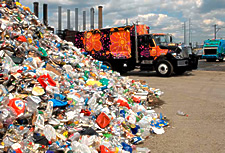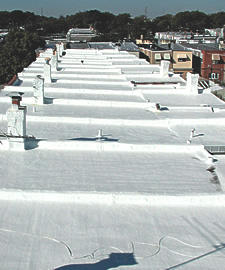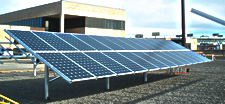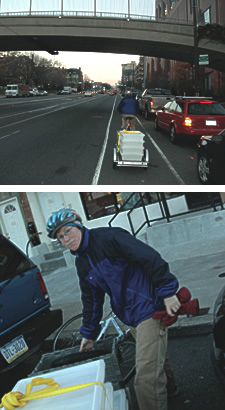 BioCycle February 2011, Vol. 52, No. 2, p. 22
BioCycle February 2011, Vol. 52, No. 2, p. 22
Mayor Michael A. Nutter pledged to make Philadelphia the greenest city in America by 2015. How is he making good on that campaign promise?
Dan Sullivan
WHEN newly minted Mayor Michael A. Nutter took office in January 2008, he pledged in his inaugural address to make Philadelphia, Pennsylvania the greenest city in America by 2015. His strategy for getting the job done included a top-down redesign of city government and installing a team of deputy mayors to oversee various departments and coordinate work between them. The team includes Deputy Mayors for Economic Development, Administration and Coordination, Health and Opportunity, Public Safety, and Transportation and Public Utilities. Perhaps the most important function the deputies serve is to talk to each other and make sure departments under their watch likewise communicate and collaborate.

Nutter also created the Mayor’s Office of Sustainability, which spent a year researching municipal sustainability and speaking with stakeholders including residents and businesses. Released in Spring 2009, Greenworks Philadelphia is a comprehensive guiding document that lays out the city’s goals and strategies for fulfilling the mayor’s inaugural promise. The plan builds upon Philadelphia’s 2007 Local Action Plan for Climate Change and considers sustainability through the five lenses of energy, environment, equity, economy and engagement. Through focused leadership, a long-term financial commitment and policy changes that include developing ecology-based design standards, the city hopes to make sustainability the new “business as usual.” Initial benchmarks of the plan include:
• Lowering city government energy consumption by 30 percent
• Reducing citywide building energy consumption by 10 percent
• Retrofitting 15 percent of housing stock with insulation, air sealing and cool roofs
• Purchasing/generating 20 percent of electricity used in Philadelphia from alternative energy sources
• Reducing greenhouse gas emissions by 20 percent
• Improving air quality toward attainment of federal standards
• Diverting 70 percent of solid waste from landfill
• Managing storm water to meet federal standards
• Providing park and recreation resources within 10 minutes of 75 percent of residents
• Bringing local food within 10 minutes of 75 percent of residents
• Increasing tree coverage toward 30 percent in all neighborhoods by 2025
• Reducing vehicle miles traveled by 10 percent
• Increasing the state of good repair in residential infrastructure, and
• Doubling the number of low- and high-skilled green jobs.
Philadelphia, with a population of over 1.5 million (making it the 6th largest city in the U.S.) is far from a wealthy city – in September 2010, the Auditor General announced it would face a $5 billion deficit in fiscal year 2011-2012. Against that backdrop, the pragmatic mayor knows environmental sustainability must walk hand-in-hand with economic progress. “This really is about jobs,” said Mayor Nutter in a September 2010 speech at the Charting New Waters conference in Washington, D.C. “It puts people to work, and we’ve seen it all throughout the city of Philadelphia and our job-training programs creating green jobs, strengthening our neighborhoods and helping us to build the greenest city in America.”
Rina Cutler, Philadelphia’s Deputy Mayor of Transportation and Utilities, echoed that sentiment in a recent conversation with BioCycle. “We think green is not just good for the environment, we think it’s good for the economy,” she says. “If it can be viable both financially and environmentally, it can be a huge game changer for the city.” Two examples of how this strategy is possible are the city’s recently overhauled recycling program and its pioneering plan to manage storm water by literally greening up the city to mimic the natural systems that were in place prior to urbanization.
“Lucky for me, water, the airport, streets, transportation and energy are all within my purview,” says Cutler, who had been executive director of the Philadelphia Parking Authority from 1994-2000. “When the mayor first got elected, he called me and said ‘would you like to come back to the city as deputy mayor for transportation and utilities?’ Combining both I found unusual and interesting. When I questioned why he would put those together, his answer was pretty clear: ‘It’s all infrastructure.’ We had a long discussion about how one integrates all pieces of that particular puzzle. It excited me to come back.”
Katherine Gajewski, Philadelphia’s mayor-appointed Director of Sustainability, notes that formally integrating sustainability into government is a relatively new function. “Sustainability requires a transition to a lifecycle analysis way of thinking and planning, for example, considering the ongoing utility and operations costs of a building rather than just the initial construction costs during the design process,” she explains. “It’s a growing part of the current national dialogue, including for the Department of Energy, trying to effectively communicate that energy efficiency makes sense and to drive the market forward.” Public officials and individuals alike are also realizing that energy efficiency and renewable energy can positively impact homeland security and economic security as well, she says. “We published Greenworks Philadelphia, our comprehensive sustainability plan, in 2009. Considering that we got going with this two years ago, I’ve been amazed by how much work is going on across the city, not only by city government but in the private sector and by communities and residents, too. At the end of the day, to make the shifts and strides that will bring sustainability fully into the mainstream, work needs to be framed around the economic development potential and economic value. The opportunities for business and job growth are real, but we need to make the commitments and investments to get there.”

GREENING STORM WATER INFRASTRUCTURE
Many of Greenworks’ sustainability goals dovetail nicely into one another. For instance, the city’s 719-page “Green City, Clean Waters” plan for managing storm water to meet federal standards by replacing concrete with green landscaping and other pervious surfaces also helps meet the goals of reducing greenhouse gases (plants and soil sequester carbon), providing additional park and recreation resources, increasing tree coverage, making the city more bicycle and pedestrian friendly, sprucing up neighborhoods and creating green jobs. The ambitious plan to manage the first inch of rainwater in a storm event via green infrastructure where possible – and by more traditional capacity building measures where it is not – is approved by federal and state environmental regulators. And its implementation will also save Philadelphia a substantial amount of money.
“Philadelphia has proposed to the U.S. EPA and the Pennsylvania Department of Environmental Protection that Green City, Clean Waters would invest $1.6 billion over 20 years using green infrastructure that will keep storm water out of our systems by recreating the natural systems that centuries of urbanization have degraded,” Nutter explained in his speech at the conference Charting New Waters last fall. The alternative is to increase the city’s storm water capture and storage capacity at an estimated cost of about $10 billion. “Our goal is to turn over 4,000 acres of impervious cover – about one third of the total drainage area – into green acreage,” he added. “In addition, we want to restore almost 20 miles of urban stream corridor. From the use of pervious pavement, green roof technology, rain barrels, storm water tree trenches, to [vegetated] bump-out curb extensions and rain gardens, our goal is to keep storm water out of our combined sewer system instead of trying to just enlarge the system.” Since that pronouncement and through negotiations, the Philadelphia Water Department (PWD) has extended the program to 25 years, which will achieve 9,500 “greened acres” and a total combined sewer overflow volume reduction of 7,960,000,000 gallons per year.

Howard Neukrug is Philadelphia’s Water Commissioner and the mastermind behind the Green Cities, Clean Water plan. “We have a significant amount of overflow rain water – with sewage and other pollutants going into our rivers and streams every time it rains,” Neukrug told BioCycle. “We’re required to do something [via the Clean Water Act], and we want to do something. Building capacity for storage in the way of tanks and tunnels to capture, pump and treat is not very sustainable and it’s very expensive. We’re talking many billions of dollars and decades for construction.”
In the Green Cities, Clean Water plan says Neukrug, “The idea is to deal with capacity and reduce the demand through reuse, recycling and infiltration and to manage our storm water before it gets in to our subsurface infrastructure or managing it so that it is released more slowly allowing for our existing capacity to handle it. Philadelphia is a very poor city. It would be best if we can do this in a way that lifts up the city, makes it more attractive and more livable – that is our real hope for the future.”
Similar to its now-successful recycling program, Philadelphia has taken a carrot-and-stick approach in encouraging private property owners to get on board with the Green City, Clean Waters program. Following three years of mapping and an equitable-cost-of-service analysis that assigned a value to storm water management, the city changed the way it bills for storm water in part to get owners of large and/or impervious property to manage storm water more responsibly. “Instead of being meter based it is based on impervious area,” explains Chris Crockett, director of planning and research for the Philadelphia Water Department (PWD). In tandem with that shift, the water department identified the 100 most affected businesses based on percentage of increase in monthly or annual payment and is meeting with each to help them identify opportunities for managing storm water on-site via green infrastructure, thereby reducing their storm water management costs. Private landowners who manage the first inch of storm water from impervious areas or reduce impervious areas are eligible for credits of up to nearly 100 percent on their storm water bill.
A critical component of achieving long-term sustainability – in this case using green infrastructure to manage storm water – is getting past the pilot phase to full-scale implementation, says Andrew Stober, chief of staff for the Mayor’s Office of Transportation and Utilities. To get there, he says, requires the leadership, financial and policy commitments to create specifically defined best practices. “For example, we’re selecting a consultant to develop a new set of design standards for green storm water infrastructure for our streets,” he explains. “We need to know the exact design specifications so that when the Street Department is rebuilding streets, they know what best practices to follow given the level of storm water intervention, the slope, etc.” Such detail might include the type of soil mix to apply to a given situation. “These will be standard best practices – we want to be innovative, but at the end of the day this will be just how it’s done.”
RECYCLING PAYS OFF
Over the past four years and beginning just prior to Mayor Nutter taking over the reins of leadership, Philadelphia has made incremental changes that have increased its recycling rate from around 7 percent to approaching 20 percent. These changes have included switching to single stream recycling with trash pick up on the same day, weekly (versus biweekly) collection, accepting cardboard and numbers 1-7 plastics, and an incentive program that includes rewards for participation and fines for noncompliance. Between the avoided costs of not landfilling the recovered materials and the revenue generated from recycling, the city is realizing a net savings of more than $1 million/month.

“We negotiated a very competitive contract with local processors,” explains Philadelphia’s Recycling Coordinator David Biddle. “In the last go-round, Waste Management won the bid.” The contract includes sharing revenues from commodity sales on a sliding scale tied to national price fluctuations and calculated quarterly. “If we get $51 a ton and we recycle 9,000 tons a month, that is not bad money,” says Biddle. Add to that the $65/ton the city saves on landfill tipping fees for that same recovered material, and the numbers speak for themselves. “Last quarter, the price we receive dropped to a little more than $30 a ton,” says Biddle. “Currently it’s at $50. It really fluctuates. We’re looking at revenue somewhere between $400,000 and $500,000 a month. This year at current collection capacity we’re verging on 10,000 tons a month, so our projected revenue for 2011 is $5 million to $6 million, which is great. This will really help the city after the global economic turmoil of the past few years.” The major investment for Philadelphia, says Biddle, was increasing its fleet capacity as well as its labor pool. “Just like anything else, you have to pay for it.” For its part, Waste Management invested $20 million in a new materials recovery facility (MRF).
The 25-year-old recycling program has traditionally run hot and cold, but mostly cold, says Biddle. He rests the program’s current and unprecedented success firmly on the shoulders of a receptive and enlightened administration. “We’ve never seen anything like this, and it is a function of having a mayor who is really committed to a sustainability mission and who understood in his campaign that a sustainability mission is vital to a huge chunk of the electorate.” While many in the past paid lip service to recycling, often questioning why the Streets Department couldn’t do a better job, Biddle says, historically no one had been willing to pony up and invest in the research or infrastructure necessary to improve the program. “The Streets Department knew all along what was necessary, they just needed somebody to listen to them. That’s where Mayor Nutter came in. It’s always been there; there’s just been this quiet potential that wasn’t being tapped. Now it’s being tapped, and the proof is in the economic benefit. None of this would have been possible if we hadn’t been given the budget to make the investment. Now the economics are really paying off.”
To help enforce its now-mandatory recycling program, the city has employed 50 SWEEP (Street and Walkway Education and Enforcement Program) officers, justified in part by the program’s success and strategically placed across six sanitation districts. “If they observe a house that does not have their recycling container out on recycling day, that’s a sign they should check the trash,” he adds. “If there is clear evidence the household is not paying attention to the recycling regulation and it’s their first offense, ideally they receive a warning. If they’ve already been given a warning, they get a ticket.” Not recycling constitutes a $50 violation. “As long as we have consistent education and enforcement, in two years it will be very rare that we are writing tickets,” Biddle continues. “If we are writing tickets, then we are not doing our job in educating our citizens.”
The “carrot” of Philadelphia’s recycling program is a partnership with RecycleBank called the Philadelphia Recycling Rewards Program. When they recycle, participating households receive points to redeem for goods and services or donations to charity. The logistics and lay of the land – Philadelphia is a 400 year old city with many dwellings sandwiched together on narrow streets – make weighing and recording the contents of individual customers’ recycling bins impractical. Instead, the points are aggregated by district (four to five recycling trucks service each district, with each customer in that district receiving equal credit for the overall district’s performance).
According to Deputy Mayor Cutler, such a model engenders a spirit of neighborhood camaraderie as well as a healthy dose of peer pressure to participate. With 125,000 households – about a quarter of the city – signed up for the rewards program and about 80 percent of residences setting out their recycling bins on any given day, Biddle says a sustainable critical mass has been reached. “I’ve been doing this for 25 years, and the biggest single mistake you can make is to push too hard too fast before you become fully successful,” he says. “We’ve got a million and a half people who speak 25 different languages. We have some of the richest people in the world and some of the poorest people in the United States. You don’t have to push too hard if you are already being successful – that’s the way I’m looking at it.”
The next piece of the puzzle is to increase Philadelphia’s institutional and commercial recycling. Diverting organic residuals such as food waste may be a part of that picture, he says, and may someday be a strategy directed to residential homeowners.

ENERGY EFFICIENCY
This past November, Mayor Nutter announced the EnergyWorks initiative, which is supported by a $25 million grant from the U.S. Department of Energy’s Better Buildings program. “It allows us to make and finance energy efficiency improvements for homes and businesses,” says sustainability director Gajewski. “This is a tremendous area of focus for Philadelphia.”
Nutter says EnergyWorks will allow the average greater Philadelphia homeowner to slash energy consumption costs by 20 percent with $1,000 to $15,000 loans available at less than one percent interest. The program also will subsidize up to $400 for an initial energy audit and chip in $300 for any homeowner willing to invest at least $1,000 in energy saving measures. On the commercial side, businesses may apply for a low-interest $100,000 to $1 million EnergyWorks loan that includes a free energy audit. Additionally, the city received a combined $30 million in 2009 through the American Recovery and Reinvestment Act to make energy efficiency improvements, increase recycling and provide energy conservation grants to small businesses.
A year after Greenworks Philadelphia was announced, the city’s self-graded progress report stated it was 39 percent of the way toward meeting its combined target energy conservation goals. Milestones included hiring an Energy Manager to focus on energy policy and an Energy Conservation Coordinator to promote awareness of energy use and conservation among city employees. Federal economic stimulus funds also enabled the city to purchase an energy-management database so departments can monitor energy use online and track progress toward reduction targets. Mayor Nutter also signed legislation requiring all new construction in the city to use highly reflective roofing materials that meet or exceed Energy Star cool roof standards while not increasing construction costs.
HARVESTING ENERGY IN WASTEWATER
Water Department Commissioner Neukrug and his team are looking toward optimizing its systems to help Philadelphia continue to reach its energy goals while providing other benefits. As an example, the Northeast Wastewater Treatment Plant (WWTP), which processes 190 million gallons of wastewater daily, is receiving ethylene glycol waste (de-icing fluid) from the Philadelphia International Airport across the street and adding it to its anaerobic digesters to boost methane production. “We’re starting to look at our facilities more as resource recovery facilities,” says Neukrug. “That’s where the relationship between the water and sanitation departments comes in.”
“The airport saves roughly $100,000 a year, and we make $100,000 a year,” adds PWD’s Crockett. Codigestion of food waste to boost methane production at wastewater treatment plants with anaerobic digesters that have capacity to process additional substrates is another waste-to-energy strategy being explored, says Crockett, as is the possibility of making biodiesel from sludge and scum (the latter project in partnership with a local business – BlackGold Biofuels – and Villanova University). “And we’re moving toward examining RFPs for a public/private partnership for the installation of a cogeneration facility at the Northeast WWTP – a 5.6 megawatt plant that will produce 86 percent of that facility’s energy needs and, with optimization, more than 100 percent. These are all building blocks. This facility is the heart and backbone that we can build upon to explore new food waste codigestion and other resource recovery technologies in the future as they become viable business models and the wastewater plant becomes a net producer of energy for PWD over the next 20 years.”
Crockett says water pumping, wastewater treatment and storm water management combined account for 40 percent of the municipal government’s total energy use. “Within PWD, water pumping is 45 percent of our energy use and wastewater treatment is 45 percent, roughly. Energy independence is our goal.” He adds that the energy potential in wastewater is 10 times greater than the energy used to treat it. “Our goal is to harvest all of that.”
For example, PWD is partnering with the private sector [Novatherm – Villanova University’s Thermal Management Laboratory] on a demonstration project to apply sewer geothermal technologies to heat and cool one of its 20,000 square-foot compressor buildings. “In China for the Olympics it was used to heat and cool the Beijing train station,” says Crockett. “The concept is very similar to ground geothermal, because the fluid in sewers is typically a constant temperature as is the ground and thus can be used as a heat source or sink for heating and cooling a building from a thermodynamic perspective.” The only issue hindering widespread use of sewer geothermal is the separation of the material in sewage that could foul and impact the heating/cooling pump system, he explains, adding that recent improvements in the reliability and performance of those separation technologies are making it more appealing.
More than 1,000 solar panels were recently installed at the Southeast Wastewater Treatment Facility to generate 250 kWh of energy for the plant’s use. “That facility has no digesters; that’s why we’re investing in other technologies. This has all happened within a short timeframe and has spurred a lot of work for us.”
Solar energy opportunities have been analyzed for all of PWD’s water and wastewater facilities as future capital projects arise, says Crocket. “After we finish getting the Northeast cogen and southeast solar projects off the ground, we will be turning our attention to taking the land on top of our finished water storage at the Baxter Water Treatment Plant and using it to lease space for a 2 to 5 MW solar farm.” If built, this system would be able to provide enough energy to treat and deliver half the city’s drinking water during a sunny day. “That project would take us one step closer to being able to deliver a ‘glass of sunshine’ to our customers,” he notes. “In fact, we call that our ‘Glass of Sunshine’ initiative.”

ALL ABOARD THE SUSTAINABILITY TRAIN
“I get accused of being anti car, which I find both funny and interesting since I drive one,” says Cutler, Deputy Mayor of Transportation and Utilities. “For me the notion of multimodal is really about giving people choices, legitimate choice as to whether they need to get in a car and drive. That means a great transit system that provides a safe and economical way to commute, and bike lanes so that you can traverse the city and not get killed, and pedestrian-safe sidewalks that are wide enough. It isn’t one favoring the other but providing all of those choices so that people can make the one that’s right for them.” From Cutler’s perspective, it comes down to livability. “You can live here without owning a car. Part of my job is to group policies and practices that allow everybody to get a shot.”
Without a doubt, the city of Philadelphia’s ability to get major federal dollars for current and planned sustainability programs has enabled it to progress toward the GreenWorks’ goals. “I think it’s a matter of both need and our capacity to get things done,” says Giridha Mallya, policy and planning director for the Philadelphia Department of Public Health, which recently received a combined $30 million in federal grant dollars to prevent tobacco use as well as obesity and related diseases.
That “git ‘er done” sentiment was echoed by Mayor Nutter in a “My Fellow Philadelphians” letter introducing Greenworks Philadelphia to his constituents: “Some people might question the wisdom of launching a strategy as ambitious as Greenworks Philadelphia given the current economy and the city’s financial problems,” the letter states. “Why start working now toward a greener, growing Philadelphia? My answer is simple. To ensure that Philadelphia’s best days are ahead of it, we must dream big – and we must dream smart. And we must take steps today that will make our city’s future more secure and more prosperous.” The mayor’s letter and call to arms continues: “Philadelphia enjoys a reputation as a city that values work – real work, honest work, hard work. So despite these economic times – or perhaps because of them – it is time once again for all Philadelphians to roll up their sleeves and get to it. Together we will build a new city.”
p. 26 Sidebar
CARBON-FREE RECYCLING AND ORGANICS COLLECTION
IT’S 6:15 on a late-November morning in West Philadelphia, and daylight won’t hit the pavement for another hour. The mercury reads 22°F and is holding steady. Amy Wilson pedals her mountain bike, pulling behind her what looks like an aluminum ladder on wheels across Woodland Avenue and into the bicycle lane in front of Four World’s Bakery.
Wilson is executive director of Pedal Coop, a nonprofit that provides bagel delivery service to area coffee shops and recycling and compostables pickup to local businesses and residences, all via pedal power. The coop was founded in 2007 by a group of college students. Currently, eight working members serve around 60 residential and commercial accounts, each rider pocketing 60 percent of the fees for service while 40 percent goes back into equipment maintenance and other operating costs. “All of our revenue comes from charging clients,” she says.

Wilson is Pedal Coop’s only full-time employee; most members work part-time. As well as delivering bagels, she covers recycling and composting routes – performed on different days and not quite so early. Pedal coop charges clients 21 cents/gallon for recycling, which includes the same materials collected by the city – 1 through 7 plastic, paper, cardboard, steel and aluminum cans and glass. “We take it to Blue Mountain Recycling,” says Wilson. Currently, Pedal Coop delivers the recycled materials single stream and does not receive any payment back from Blue Mountain. If the coop took the time to separate what’s collected, it could be a potential revenue stream. “It’s worth looking into,” Wilson says. “It would take more time to sort, and we’d need to determine if the revenue it would generate would be significant enough to prioritize the work.” Several offices serviced by the coop use it to recycle paper only.
While the city of Philadelphia provides single-stream residential curbside recycling service at no charge, businesses must contract with a private hauler. “That’s where we fit in,” she explains. “We’re more expensive if you are really big, but for a small office or nonprofit business, we’re pretty comparable. There’s no Dumpster fee, and you miss some of the other charges. We’re unlike any other waste pick up service I know of, in that we go inside offices, etc., and empty the bins for them. They save staff time and have more personal service. It’s good for us as it allows us an opportunity to check in with our customers and answer any questions.”
Pedal Coop also offers more flexibility, she adds. For instance, the city closes its streets to trash trucks during certain hours of the day; the coop operates under no such restrictions. Pick ups range from as little as 5 gallons every other week from some residential compost customers – who are each provided a 5-gallon bucket – to more than 300 gallons twice a week from a local microbrewery. Three 100-gallon bins is the maximum each custom-built Bikes-at-Work cargo trailer can hold. “The route is up to the rider,” says Wilson, “as long as you get there when you say you’re going to get there.” Compost customers are charged 83 cents/gallon.
Compostables were originally delivered to a community garden in West Philadelphia near the University of Pennsylvania campus and more recently to a vacant city lot harboring an assortment of wooden compost bins near Four World’s bakery. “We outgrew our previous space and were also looking for somewhere with fewer neighbors so that it would not be disruptive for us to come and go frequently,” Wilson explains. Now Pedal Coop is brokering a deal with community gardens in South and West Philadelphia. “We’re hoping to partner with community gardeners along our compost routes to deliver food scraps that can become fertile soil for urban farmers, particularly those farming in food deserts. We won’t charge the gardeners anything, as they are helping us reduce our workload and making our routes more local.”
While Wilson feels the coop presents a viable business model – in fact, finding enough riders to accommodate the demand has been a challenge – she sees the mission more as an opportunity to demonstrate what is possible. Such a carbon-free approach to recycling could go hand-in-glove with Philadelphia’s desire to be the greenest city in America. “I think it would be good if we weren’t around in 10 years, and the city shows its commitment to sustainability by doing this.” Learn more about Pedal Coop at www.pedalcoop.org.
February 22, 2011 | General










